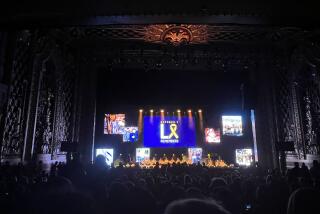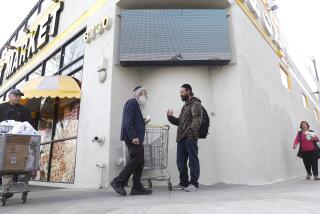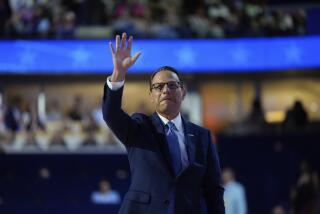Counting Jews is more than a math problem
- Share via
For a group that traditionally has viewed the counting of its members with ambivalence, the Jewish community is devoting a great deal of scrutiny and debate to population surveys.
Take, for example, the discussion generated by the recent publication of a study by Brandeis University that estimated the U.S. Jewish population at 6 million to 6.4 million, roughly 1 million larger than thought.
Fears of rising intermarriage rates and assimilation have made Jewish population studies a hot-button topic among many in the community. But surveys of the Jewish population also speak to the morale of the community.
“There’s always this debate ... are things getting better or worse?” said Bruce Phillips, professor of sociology at Hebrew Union College in Los Angeles. “People who think it’s getting worse say, ‘Well, there’s more Jews, so we’re doing a worse job in connecting with them.’ Others say the Jewish community has been doing a good job in keeping people Jewish because there’s actually more Jews than we thought.”
Perhaps fittingly, Judaism treats the counting of Jews with a “traditional ambivalence,” said Rabbi Mark S. Diamond, executive vice president of the Board of Rabbis of Southern California. The Hebrew Bible describes a census, but rather than count people individually, a half shekel is collected from each Jew. A sacrifice performed afterward is often interpreted as an atonement, Diamond said.
“Part of it has to do with going back to the Torah -- the notion of counting people. It was believed that if you know somebody’s number or name, you know their essence, and that is a prerogative reserved for God alone,” Diamond said.
Many Jews today get around this ambivalence when checking if they have a quorum for prayer. Some will recite a 10-word sentence, noting whether there’s a person for each word.
Others will count in a roundabout way by saying “not one, not two, not three” and so on.
Jewish population studies have been conducted regionally, statewide and nationwide. Among those studies is the National Jewish Population Survey, which has been conducted in 1970, 1990 and 2000.
The last study created waves in the Jewish community when it suggested that the U.S. Jewish population had declined since 1990 from 5.5 million to 5.2 million.
Laurence Kotler-Berkowitz, who worked on the 2000 survey, said that 5.2 million is probably a “small undercount.”
Enter Leonard Saxe, director of the Steinhardt Social Research Institute at Brandeis.
The Brandeis report is a study of studies, or a “meta-analysis,” which integrated data from 34 existing surveys that asked about religion.
“What some people ask is ‘Why does anybody care how many there are?’ ” Saxe said. “In the Jewish community the numbers, especially since they all hover around 6 million, have particular relevance. In the wake of the Holocaust, where 6 million were killed, how many Jews are remaining and whether the community is regenerating or not -- it’s a very sensitive issue.”
Part of the counting problem the Brandeis study attempted to overcome is the statistical difficulty of surveying a rare population.
About 2% of the U.S. population is Jewish, which means that for about every 100 telephone calls for a survey, only two people will be Jewish.
Another core problem in Jewish demographics is the concept of identity -- what does it mean to be Jewish? In the Brandeis study, for the most part, people were counted as Jewish if they said they were, or if they were raised in a Jewish household and were not following another monotheistic religion. Many Orthodox consider a person Jewish only if their mother is a Jew.
The U.S. Census does not ask people about religion, and Jewish demographers in the United States often talk somewhat jealously of Canada’s census, which does survey religious affiliations.
In Canada, people may respond with “Jewish” for their religion, as well as their ethnicity. This leads to some interesting results, said Barry Kosmin, who directed the 1990 National Jewish Population Survey.
Some Canadians will identify themselves as religiously Jewish, but not ethnically Jewish, or vice versa. The Canadian experience, Kosmin said, demonstrates the difficulty of counting Jews.
“You can get a scholarly conference convened at the drop of the hat to decide whether Jews are a religion, ethnicity, race, people, nationality or what have you,” said Charles Kadushin, a sociology professor and scholar of the Cohen Center for Modern Jewish Studies, who worked on the Brandeis study.
In Greater Los Angeles, according to the 1997 Los Angeles Jewish Population Survey, the most recent survey of its kind, there are about 520,000 Jews. This population is the second-largest outside of Israel, after New York, which has about 1.4 million Jews.
The nationwide estimate in the Brandeis study speaks to the strength of the community and to its potential political influence, said Kotler-Berkowitz.
But Michael Steinhardt, president of the Jewish Life Network and whose institute conducted the Brandeis study, said the study also demonstrates the need to reach out to large segments of the Jewish population that have not been recognized before.
The Brandeis study “presents some very provocative questions, and I think it presents some ... challenges for the organized Jewish community,” said John Fishel, president of the Jewish Federation of Greater Los Angeles. “If there are 1 million more people who self-identify themselves as Jewish, how do we as a service organization engage these people?”
The issues of identity and intermarriage arise again and again in Jewish population studies.
The Brandeis study, which was released in January, emphasized the 6 million to 6.4 million estimate, but added that the population could be as large as 7.5 million if others, mainly children of intermarried couples, were included.
Other studies have looked at how such children were raised. According to a nationwide study in 2004 by Brandeis, 32% of intermarried couples raised their children as Jewish. Another study, led by Phillips in 1993, had put that figure at 18%.
The New Community Jewish High School in West Hills is one example of attempts within the community to reach out to younger Jews of all kinds and to inculcate a connection to Judaism that will last throughout their lives, according to Rabbi David Vorspan, the school’s rabbi in residence.
Only 4 1/2 years old, the school has 340 students. About 17% are affiliated with an Orthodox synagogue, and the rest span synagogue affiliations of Reconstructionist, Reform, Conservative or unaffiliated.
In December, Vorspan met with many of the school’s first graduates, who were finding their niches as freshmen in college.
He said that many he had taught as high school freshmen, who had not been connected to the Jewish community, were now active participants in college Jewish activities or groups.
“For a lot of these kids, the Jewish community has become more important to them than it was before they came into our school,” Vorspan said. And this, many Jewish leaders would say, is what counts most.
More to Read
Sign up for Essential California
The most important California stories and recommendations in your inbox every morning.
You may occasionally receive promotional content from the Los Angeles Times.










